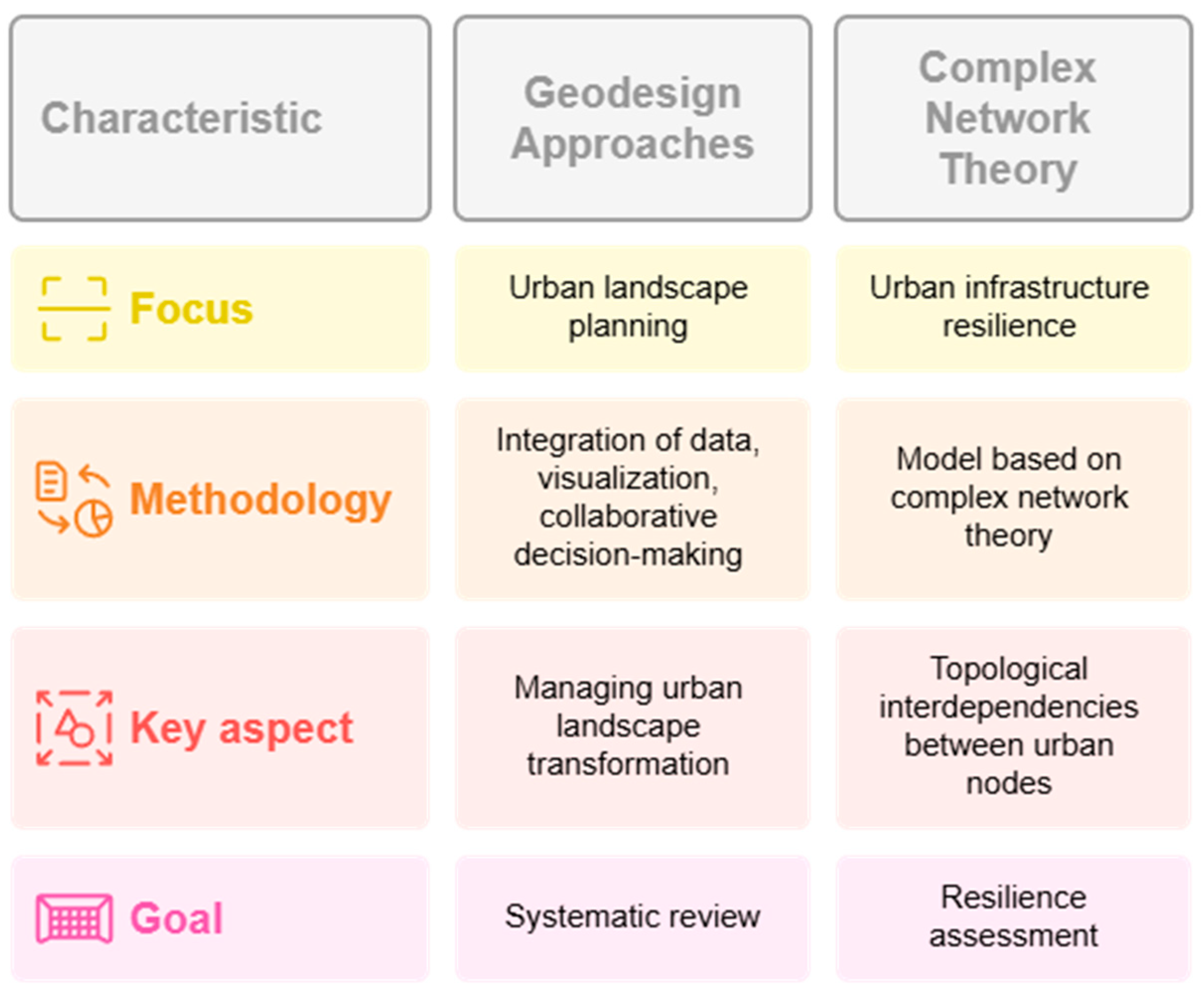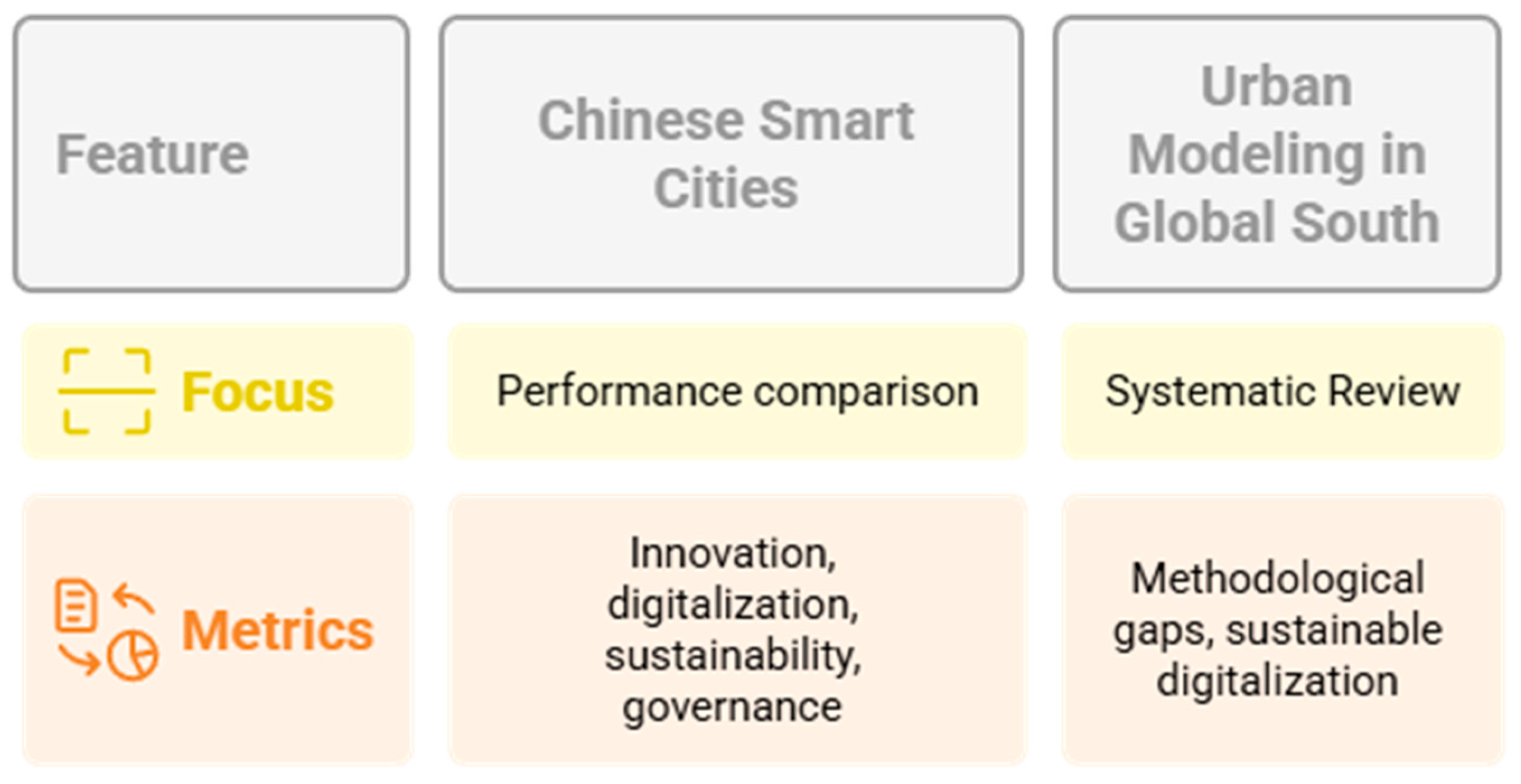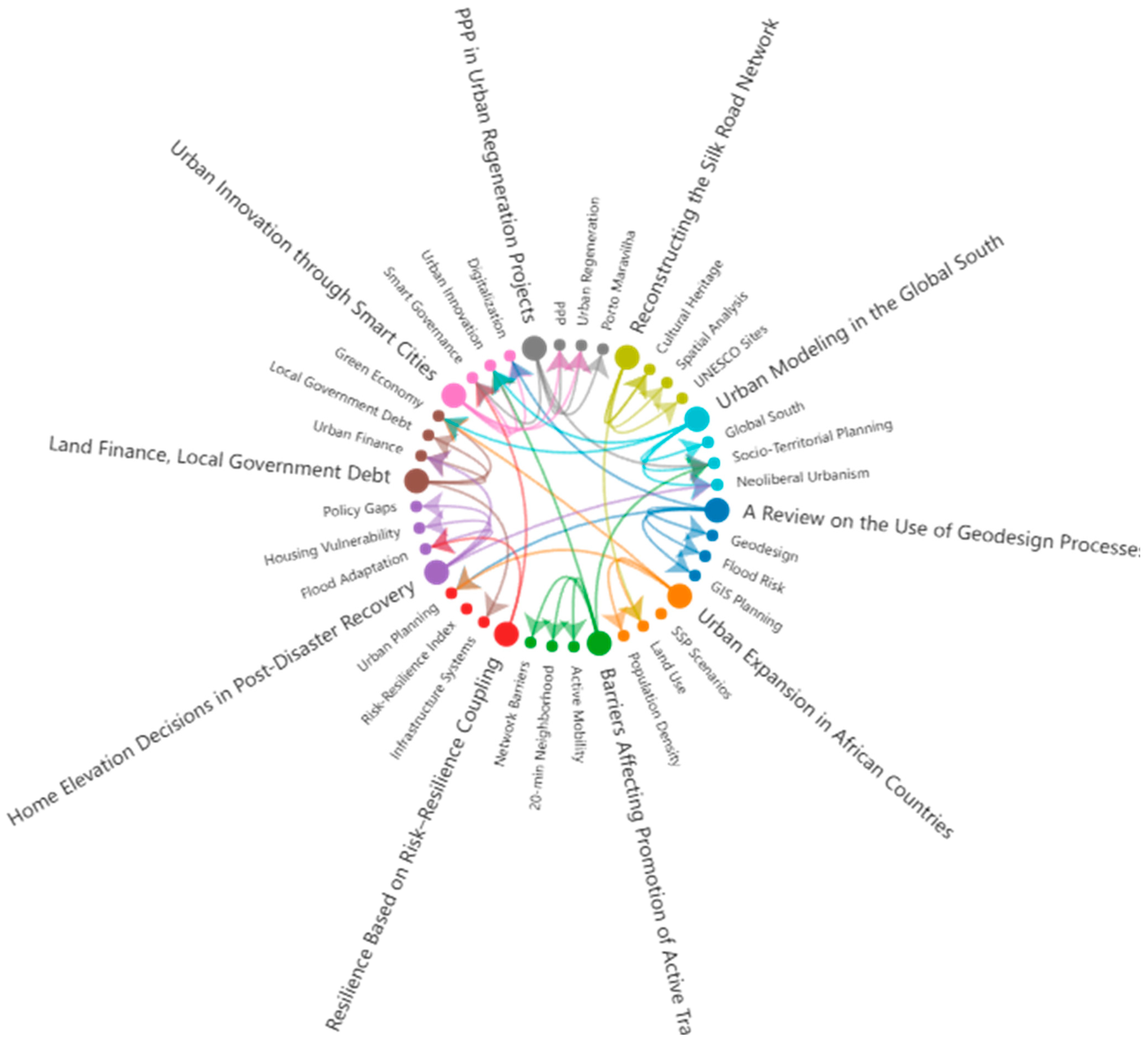Resilient Cities and Land Take Effective Management Through Sustainable Urban Planning Tools
1. Introduction
- The assessment and management of urban and infrastructural resilience, with methodological proposals for measuring the interaction between risks and the adaptive capacity of cities;
- Planning tools and policies for land take-over mitigation, including analysis of land use in rapidly urbanizing areas and strategies for rational land use;
- Innovation and urban governance through smart cities and digitalization, with experimental evidence on the benefits of digital transformation for urban innovation;
- Social inclusion, equity, and participation in urban regeneration, taking into account the impacts of public policies and public–private partnerships.
2. Authors’ Institutions
3. Main Topics Addressed
- Tools and models for the assessment of urban resilience
- -
- A Review on the Use of Geodesign Processes in Managing Urban Landscape Transformation di Bo Pang and Brian Deal outlines a systematic review of geodesign approaches applied to urban landscape planning and transformation, with a focus on the integration of data, visualization and collaborative decision-making.
- -
- Evaluation of Urban Infrastructure Resilience Based on Complex Network Theory di Dong, W., Zhou, Y., Guo, D., Chen, Z., & Wang, J. proposes an innovative model based on complex network theory to assess the resilience of urban infrastructures, considering topological interdependencies between urban nodes.
- 2.
- Land take-over management and spatial transformations
- -
- Analysis of the Spatial Pattern of Urban Expansion in African Countries from 1990 to 2018 by Liu, B., Xie, S., Chen, M., Yao, N., & Liu, W. presents a large-scale study in which remote sensing data and spatial analysis techniques were used to describe urban sprawl in Africa and its implications for land management.
- -
- In Land Finance, Local Government Debt and Economic Growth: Evidence from China, Zhao, Y., Peng, S., Zhang, Q., Wang, Y., Gong, C., & Lu, X. analyze the link between land finance, local debt, and urban development, highlighting risks and opportunities in tax policies related to urbanization.
- -
- Reconstructing the Silk Road Network: Insights from a Large-Scale Spatial Interaction Model by Shen, Y., Liu, J., Han, J., & Wan, X. details how an interactive spatial model was used to reconstruct the historical and geographical structure of the Silk Road network, offering insights into how cultural networks influence urban evolution.
- 3.
- Urban innovation and smart cities
- -
- In Promoting Urban Innovation through Smart Cities: Evidence from the Top 20 Smart Cities in China, Ji, M., Jin, M., Chen, L., Liu, Y., & Tian, Y. compare the performance of 20 Chinese smart cities through indicators of innovation, digitalization, sustainability, and urban governance.
- -
- Urban Modeling in the Global South and Sustainable Development: A Systematic Review by Anne K. Kurjenoja provides a systematic review of urban models in the context of the Global South, highlighting methodological gaps and potential for the sustainable digitalization of planning practices.
- 4.
- Public policies, participation, and inclusion
- -
- In Barriers Affecting Promotion of Active Transportation: A Study in Karachi, Pakistan, Olayode, I.O., Chau, H.W., & Jamei, E. carry out an analysis of the regulatory, cultural, and infrastructural obstacles to the promotion of active mobility in a complex and high-density urban context.
- -
- Home Elevation Decisions in Post-Disaster Recovery: Social and Policy Influences in Houston, TX by García, I., Tao, Z., Orduña, J., Martínez-Román, L., & Welideniya, W. is a qualitative study that explores the social, political, and economic factors that influence post-disaster reconstruction and adaptation decisions.
- -
- In Public–Private Partnerships in Urban Regeneration Projects: The Case of Porto Maravilha, Rio de Janeiro, Vale de Paula, P., Cunha Marques, R., & Gonçalves, J.M. critically assess the effectiveness of PPP in urban regeneration processes, analyzing the risks of social exclusion and imbalances in the distribution of benefits.
- -
- Urban Planning links to at least four articles, including those on urban resilience in Zhengzhou, flood risk management through geodesign, and the analysis of urban expansion models in Africa. This highlights the centrality of planning as a cognitive infrastructure capable of integrating diverse (technological, social, and environmental) and transversal approaches.
- -
- Smart Governance and Urban Innovation are addressed in numerous articles, including those focused on areas that are apparently distant from one another, such as urban regeneration through PPP or the promotion of active mobility.
- -
- Green Economy, Socio-Territorial Planning, and Neoliberal Urbanism trace a common thread between studies focused on varying national and international contexts (China, Brazil, the Global South), but they are united via reflection on the relationship between economic models and urban realities.
4. Conclusions
Author Contributions
Funding
Acknowledgments
Conflicts of Interest
References
- Mendizabal, M.; Heidrich, O.; Feliu, E.; García-Blanco, G.; Mendizabal, A. Stimulating urban transition and transformation to achieve sustainable and resilient cities. Renew. Sustain. Energy Rev. 2018, 94, 410–418. [Google Scholar] [CrossRef]
- Mitchell, D.; Enemark, S.; Van der Molen, P. Climate resilient urban development: Why responsible land governance is important. Land Use Policy 2015, 48, 190–198. [Google Scholar] [CrossRef]
- Datola, G. Implementing urban resilience in urban planning: A comprehensive framework for urban resilience evaluation. Sustain. Cities Soc. 2023, 98, 104821. [Google Scholar] [CrossRef]
- Palla, A.; Pezzagno, M.; Spadaro, I.; Ermini, R. Participatory Approach to Planning Urban Resilience to Climate Change: Brescia, Genoa, and Matera—Three Case Studies from Italy Compared. Sustainability 2024, 16, 2170. [Google Scholar] [CrossRef]
- Guo, N.; Wu, F.; Sun, D.; Shi, C.; Gao, X. Mechanisms of resilience in cities at different development phases: A system dynamics approach. Urban Clim. 2024, 53, 101793. [Google Scholar] [CrossRef]
- Acuti, D.; Bellucci, M. Resilient cities and regions: Planning, initiatives, and perspectives. In Climate Action; Springer: Berlin/Heidelberg, Germany, 2020; pp. 763–774. [Google Scholar]
- Barbarossa, L.; Pappalardo, V.; Martinico, F. Building the resilient city. Strategies and tools for the city masterplan. UPLanD-J. Urban Plan. Landsc. Environ. Des. 2018, 3, 15–24. [Google Scholar]
- Moraci, F.; Errigo, M.F.; Fazia, C.; Burgio, G.; Foresta, S. Making less vulnerable cities: Resilience as a new paradigm of smart planning. Sustainability 2018, 10, 755. [Google Scholar] [CrossRef]
- Locurcio, M.; Tajani, F.; Anelli, D. Sustainable urban planning models for new smart cities and effective management of land take dynamics. Land 2023, 12, 621. [Google Scholar] [CrossRef]
- Jha, A.K.; Miner, T.W.; Stanton-Geddes, Z. (Eds.) Building Urban Resilience: Principles, Tools, and Practice; World Bank Publications: Washington, DC, USA, 2013. [Google Scholar]
- Hao, H.; Wang, Y.; Chen, J. Empowering Scenario Planning with Artificial Intelligence: A Perspective on Building Smart and Resilient Cities. Engineering 2024, 43, 272–283. [Google Scholar] [CrossRef]
- Anwar, M.R.; Sakti, L.D. Integrating artificial intelligence and environmental science for sustainable urban planning. IAIC Trans. Sustain. Digit. Innov. (ITSDI) 2024, 5, 179–191. [Google Scholar] [CrossRef]
- Bocca, A. Sustainable development and proximity city. The environmental role of new public spaces. TeMA-J. Land Use Mobil. Environ. 2024, 17, 71–87. [Google Scholar]
- Karimi, F.; Sultana, S. Urban expansion prediction and land use/land cover change modeling for sustainable urban development. Sustainability 2024, 16, 2285. [Google Scholar] [CrossRef]
- Sicuaio, T.; Zhao, P.; Pilesjo, P.; Shindyapin, A.; Mansourian, A. Sustainable and resilient land use planning: A multi-objective optimization approach. ISPRS Int. J. Geo-Inf. 2024, 13, 99. [Google Scholar] [CrossRef]
- Mehryar, S.; Sasson, I.; Surminski, S. Supporting urban adaptation to climate change: What role can resilience measurement tools play? Urban Clim. 2022, 41, 101047. [Google Scholar] [CrossRef]
- Kalfas, D.; Kalogiannidis, S.; Chatzitheodoridis, F.; Toska, E. Urbanization and land use planning for achieving the sustainable development goals (SDGs): A case study of Greece. Urban Sci. 2023, 7, 43. [Google Scholar] [CrossRef]
- Asadzadeh, A.; Fekete, A.; Khazai, B.; Moghadas, M.; Zebardast, E.; Basirat, M.; Kötter, T. Capacitating urban governance and planning systems to drive transformative resilience. Sustain. Cities Soc. 2023, 96, 104637. [Google Scholar] [CrossRef]
- Sharifi, A.; Yamagata, Y. Resilience-oriented urban planning. In Resilience-Oriented Urban Planning: Theoretical and Empirical Insights; Springer: Berlin/Heidelberg, Germany, 2018; pp. 3–27. [Google Scholar]
- Suleimany, M.; Gonbad, M.R.S.; Naghibizadeh, S.; Niri, S.D. Artificial intelligence as a tool for building more resilient cities in the climate change era: A systematic literature review. In Artificial Intelligence and Machine Learning Applications for Sustainable Development; CRC Press: Boca Raton, FL, USA, 2025; pp. 60–81. [Google Scholar]
- Almulhim, A.I. Building Urban Resilience Through Smart City Planning: A Systematic Literature Review. Smart Cities 2025, 8, 22. [Google Scholar] [CrossRef]
- Morano, P.; Tajani, F.; Guarnaccia, C.; Anelli, D. An optimization decision support model for sustainable urban regeneration investments. WSEAS Trans. Environ. Dev. 2021, 17, 1245–1251. [Google Scholar] [CrossRef]
- Locurcio, M.; Tajani, F.; Anelli, D.; Ranieri, R. A multi-criteria composite indicator to support sustainable investment choices in the built environment. Valori E Valutazioni 2022, 30, 85–100. [Google Scholar] [CrossRef]
- Locurcio, M.; Tajani, F.; Morano, P.; Anelli, D.; Manganelli, B. Credit risk management of property investments through multi-criteria indicators. Risks 2021, 9, 106. [Google Scholar] [CrossRef]
- Calbick, K.S.; Day, J.C.; Gunton, T.I. Land use planning implementation: A ‘best practices’ assessment. Environ. A J. Interdiscip. Stud. 2003, 31, 69–82. [Google Scholar]
- Jones, C.; Baker, M.; Carter, J.; Jay, S.; Short, M.; Wood, C. Strategic Environmental Assessment and Land Use Planning: An International Evaluation; Taylor & Francis: Abingdon, UK, 2013. [Google Scholar]






| Typology | Number of Institutions | Institution |
|---|---|---|
| Public universities | 11 |
|
| Private universities | 4 |
|
| Academic research centers (public or private) | 6 |
|
| Government research centers (technical or professional) | 1 |
|
| Government agencies | 1 |
|
Disclaimer/Publisher’s Note: The statements, opinions and data contained in all publications are solely those of the individual author(s) and contributor(s) and not of MDPI and/or the editor(s). MDPI and/or the editor(s) disclaim responsibility for any injury to people or property resulting from any ideas, methods, instructions or products referred to in the content. |
© 2025 by the authors. Licensee MDPI, Basel, Switzerland. This article is an open access article distributed under the terms and conditions of the Creative Commons Attribution (CC BY) license (https://creativecommons.org/licenses/by/4.0/).
Share and Cite
Anelli, D.; Morano, P.; Locurcio, M.; Tajani, F. Resilient Cities and Land Take Effective Management Through Sustainable Urban Planning Tools. Land 2025, 14, 1335. https://doi.org/10.3390/land14071335
Anelli D, Morano P, Locurcio M, Tajani F. Resilient Cities and Land Take Effective Management Through Sustainable Urban Planning Tools. Land. 2025; 14(7):1335. https://doi.org/10.3390/land14071335
Chicago/Turabian StyleAnelli, Debora, Pierluigi Morano, Marco Locurcio, and Francesco Tajani. 2025. "Resilient Cities and Land Take Effective Management Through Sustainable Urban Planning Tools" Land 14, no. 7: 1335. https://doi.org/10.3390/land14071335
APA StyleAnelli, D., Morano, P., Locurcio, M., & Tajani, F. (2025). Resilient Cities and Land Take Effective Management Through Sustainable Urban Planning Tools. Land, 14(7), 1335. https://doi.org/10.3390/land14071335








